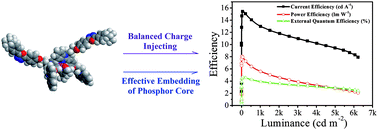A series of electrophosphorescent small molecular Ir3+ complexes IrPBIO22, IrPBICO, IrPBIO44 and IrPBIC22O22 for solution-processable host-free organic light-emitting diodes (OLEDs) were designed and synthesized, in which the electron-transporting 1,3,4-oxadiazole (OXD) and hole-transporting carbazole moieties were introduced through aliphatic chains to achieve balanced carrier injection/transporting. The coordinatable OXD groups were successfully and conveniently introduced through the post-substitution of Ir3+ cores. The photophysical investigation showed that compared with the single-position substituted counterparts, the double-position substitution is superior in restraining the quenching effect in solid states to endow the corresponding complexes with the much higher photoluminescence quantum yield (PLQY) in the film. The influences of peripheral carrier transporting (CT) moieties on the energy levels of frontier molecular orbitals were investigated with UPS analysis and Density Function Theory calculation. The dramatic electroluminescent (EL) performance of IrPBIC22O22 based on its host-free spin-coat phosphorescent organic light-emitting diodes (PHOLEDs), especially the remarkably restrained efficiency roll-off less than 16% at 1000 cd m−2 was realized, which demonstrated that the combined modification of the effective segregation of emitting cores by multi-position encapsulation and the balanced carrier injection/transporting through bipolar substitution is an effective strategy for realizing high-efficiency small molecular electrophosphorescent materials with the features of solution processability and strong restraining effect on quenching for host-free devices.

You have access to this article
 Please wait while we load your content...
Something went wrong. Try again?
Please wait while we load your content...
Something went wrong. Try again?


 Please wait while we load your content...
Please wait while we load your content...